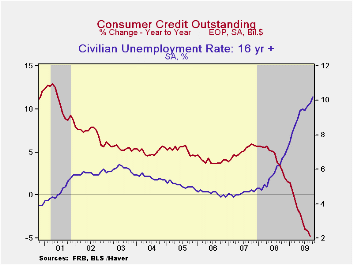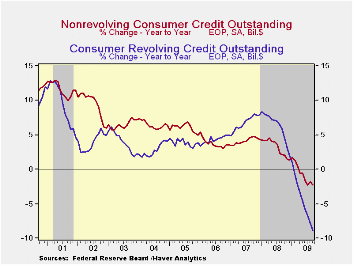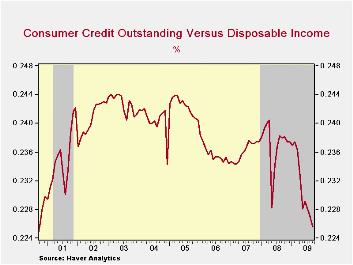 Global| Nov 09 2009
Global| Nov 09 2009U.S. Consumer Credit Outstanding Continues To Fall
by:Tom Moeller
|in:Economy in Brief
Summary
Consumers continue to deleverage as the prospects for employment remain uncertain. The Federal Reserve reported late Friday that consumer credit outstanding fell for the eighth consecutive month during September. It also was the [...]
 Consumers
continue to deleverage as the prospects for employment remain
uncertain. The Federal Reserve reported late Friday that consumer
credit outstanding fell for the eighth consecutive month during
September. It also was the twelfth monthly decline since summer, 2008.
The $14.9B drop from August followed declines during the prior two
months which were revised shallower, but the y/y change amounted to a
record 4.8% drop. With these declines, consumers have reduced
credit outstanding as a percentage of disposable income to 22.6% from
its 2005 high of 24.4%. This compares to the low near 16% in the
early-1990s.
Consumers
continue to deleverage as the prospects for employment remain
uncertain. The Federal Reserve reported late Friday that consumer
credit outstanding fell for the eighth consecutive month during
September. It also was the twelfth monthly decline since summer, 2008.
The $14.9B drop from August followed declines during the prior two
months which were revised shallower, but the y/y change amounted to a
record 4.8% drop. With these declines, consumers have reduced
credit outstanding as a percentage of disposable income to 22.6% from
its 2005 high of 24.4%. This compares to the low near 16% in the
early-1990s.
 Usage of non-revolving credit (autos &
other consumer durables), which accounts for nearly two-thirds of the
total, fell $4.9B after a slight August increase. The 2.3% y/y decline
was a record. Consumers continued also to cut back on revolving credit
usage. During September it fell a near-record $9.9B for the twelfth
consecutive monthly drop. Year-to-year the 8.8% decline is by far the
record as consumers continued to shy away from liberal spending.
Usage of non-revolving credit (autos &
other consumer durables), which accounts for nearly two-thirds of the
total, fell $4.9B after a slight August increase. The 2.3% y/y decline
was a record. Consumers continued also to cut back on revolving credit
usage. During September it fell a near-record $9.9B for the twelfth
consecutive monthly drop. Year-to-year the 8.8% decline is by far the
record as consumers continued to shy away from liberal spending.
Finance companies (-12.3% y/y), savings institutions (-9.8% y/y),
nonfinancial businesses (-6.4%) and commercial banks (-1.5% y/y have
seen the largest pullbacks in credit extension while credit unions
continue to see positive growth (1.9% y/y).  The Federal government and
Sallie Mae also continued to lend during September and raised credit
outstanding by 23.9% y/y which was the strongest growth rate since
early-2001.· These figures are the major input to the Fed's quarterly
Flow of Funds accounts for the household sector.
The Federal government and
Sallie Mae also continued to lend during September and raised credit
outstanding by 23.9% y/y which was the strongest growth rate since
early-2001.· These figures are the major input to the Fed's quarterly
Flow of Funds accounts for the household sector.
Credit data are available in Haver's USECON database. The Flow of Funds data are in Haver's FFUNDS database.
Monetary Policy Stance: The View From Consumption Spending from the Federal Reserve Bank of St. Louis is available here
| Consumer Credit Outstanding (m/m Chg, SAAR) | September | August | Y/Y | 2008 | 2007 | 2006 |
|---|---|---|---|---|---|---|
| Total | $-14.8B | $-9.9B | -4.8% | 1.6% | 5.6% | 4.1% |
| Revolving | $-9.9B | $-10.1B | -8.8% | 1.9% | 7.8% | 5.0% |
| Non-revolving | $-4.9B | $0.2B | -2.3% | 1.4% | 4.4% | 3.6% |
Tom Moeller
AuthorMore in Author Profile »Prior to joining Haver Analytics in 2000, Mr. Moeller worked as the Economist at Chancellor Capital Management from 1985 to 1999. There, he developed comprehensive economic forecasts and interpreted economic data for equity and fixed income portfolio managers. Also at Chancellor, Mr. Moeller worked as an equity analyst and was responsible for researching and rating companies in the economically sensitive automobile and housing industries for investment in Chancellor’s equity portfolio. Prior to joining Chancellor, Mr. Moeller was an Economist at Citibank from 1979 to 1984. He also analyzed pricing behavior in the metals industry for the Council on Wage and Price Stability in Washington, D.C. In 1999, Mr. Moeller received the award for most accurate forecast from the Forecasters' Club of New York. From 1990 to 1992 he was President of the New York Association for Business Economists. Mr. Moeller earned an M.B.A. in Finance from Fordham University, where he graduated in 1987. He holds a Bachelor of Arts in Economics from George Washington University.






